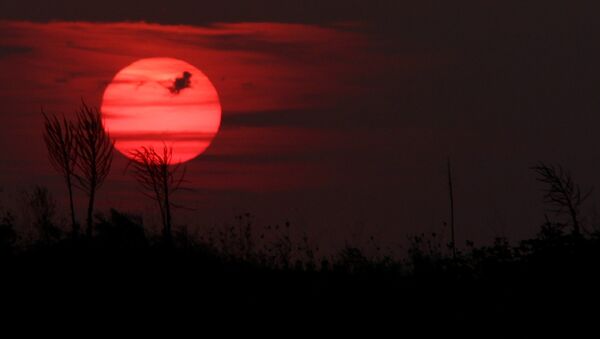Earlier this week, many Finns were taken aback by the unusual sight of a bright red sun that rose over the Nordic country. Snapshots of the blood-red sun became one of the most popular trends this week. Meanwhile, in neighboring Sweden, a rare darkness that gathered over the center of the country triggered strong reactions.
Meteorologist Anne Borgström of Finnish national broadcaster Yle argued that the awe-inspiring spectacle could be attributed to the amount of particles in the atmosphere.
"They originate from forest fires in Portugal and Spain, as well as sand and dust from the Sahara desert," Anne Borgström said.
While suspicions were immediately directed at Hurricane Ophelia, which hit Ireland on Monday, Borgström could not confirm that Ophelia was the culprit behind the red sun's manifestation. Instead, she maintained that particles had been brought by the winds from southern Europe, which is unusual but not exceptional.
Punaisena aurinko helottaa Helsingin yllä #aurinko #helsinki pic.twitter.com/ftNydcaDp2
— Riku Kettunen (@KettunenRiku) 17 октября 2017 г.
"We often experience particles from forest fires in the east. Now, high pressure is strong across southern and central Europe, and the winds have brought the air all this way," Borgström argued, admitting that a little sand from the Sahara may possibly land in Finnish streets, however not enough to really be noticeable.
"On the satellite image, a uniform dust streak coming via the Netherlands and southern Sweden to southern Finland and Eastern Europe is perfectly visible," senior researcher Seppo Hassinen at the Meteorological Institute said, as quoted by the Finnish daily Vasabladet, estimating that about a third of the particles came from the Sahara sands.
Many Swedes wondered where the sunlight had gone.
"Is the sun planning to go up today or what?" lawyer Sanna Bergenheim tweeted.
Det här var så läskigt, aldrig varit med om sådant kompakt mörker på förmiddagen i Stockholm #mörker https://t.co/GdcaudvsBI
— Madonnan (@Madonnan2011) 17 октября 2017 г.
However, the scientific circles quickly dispelled their fellow Swedes' worries.
Vilket mörker i morse, Armageddon?? #armageddon #mörker pic.twitter.com/hzquxIhsGq
— L Herlitz (@007Hertz) 17 октября 2017 г.
"It's not Judgment Day or anything. We simply have a passing weather phenomenon. It is a proper front with a lot of dense clouds. In the case of heavy rainclouds, the sky can darken very quickly," meteorologist Marcus Sjöstedt of the Swedish Meteorological and Hydrological Institute (SMHI) told Swedish Radio.
Kollega sai napattua tämänaamuisesta auringosta hienon kuvan! #aurinko #forecasuomi #sää pic.twitter.com/EzRs0dIDAa
— Foreca Suomi (@forecasuomi) 17 октября 2017 г.
His fellow meteorologist Ian Engblom at Foreca drew comparisons with what recently happened in the UK, where the sun turned bright red amid an orange sky, which was blamed on dust from forest fires from Spain and Portugal, as well as Hurricane Ophelia, the Swedish daily Aftonbladet reported.
Because no one else is posting anything about this..#ophelia #redsky #armageddon #london @Royal_Greenwich #stormyskies #roomwithaview #epic pic.twitter.com/EHJgZUpwcO
— Ella Ling (@EllaLing23) 16 октября 2017 г.
#Aurinko 17.10.2017. 🌞📷 pic.twitter.com/xm0I0i65BK
— jaakko paajanen (@jaakkopaajanen) 17 октября 2017 г.
Sun on October 17, 2017 at 8:43 a.m. in Tampere Region, Finland.#redsun #sun #aurinko #punainenaurinko #finland #pirkanmaa#sää #weather pic.twitter.com/7p9Jwc0oFK
— Elisa (@elisairm) 17 октября 2017 г.
#aurinko is now trending in Finlandhttps://t.co/WidvFjHW6n pic.twitter.com/BSlazvOktQ
— Trends Suomi (@TrendsSuomi) 17 октября 2017 г.
Skogsbränder och sand förorsakade röd sol.https://t.co/g093b3SUnn
— Hufvudstadsbladet (@hblwebb) 17 октября 2017 г.



